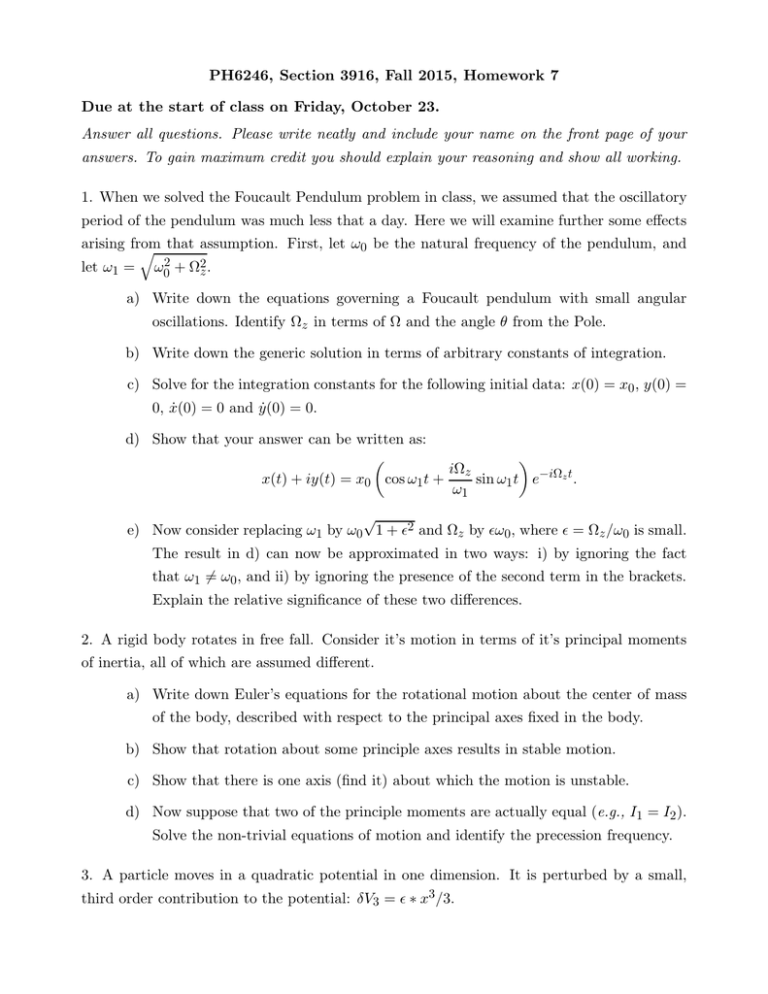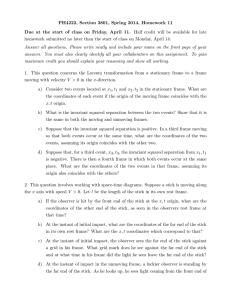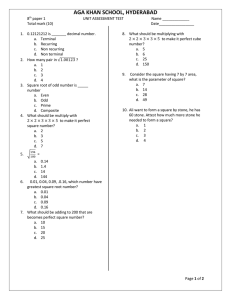PH6246, Section 3916, Fall 2015, Homework 7
advertisement

PH6246, Section 3916, Fall 2015, Homework 7 Due at the start of class on Friday, October 23. Answer all questions. Please write neatly and include your name on the front page of your answers. To gain maximum credit you should explain your reasoning and show all working. 1. When we solved the Foucault Pendulum problem in class, we assumed that the oscillatory period of the pendulum was much less that a day. Here we will examine further some effects arising from q that assumption. First, let ω0 be the natural frequency of the pendulum, and let ω1 = ω02 + Ω2z . a) Write down the equations governing a Foucault pendulum with small angular oscillations. Identify Ωz in terms of Ω and the angle θ from the Pole. b) Write down the generic solution in terms of arbitrary constants of integration. c) Solve for the integration constants for the following initial data: x(0) = x0 , y(0) = 0, ẋ(0) = 0 and ẏ(0) = 0. d) Show that your answer can be written as: iΩz sin ω1 t e−iΩz t . x(t) + iy(t) = x0 cos ω1 t + ω1 √ e) Now consider replacing ω1 by ω0 1 + ǫ2 and Ωz by ǫω0 , where ǫ = Ωz /ω0 is small. The result in d) can now be approximated in two ways: i) by ignoring the fact that ω1 6= ω0 , and ii) by ignoring the presence of the second term in the brackets. Explain the relative significance of these two differences. 2. A rigid body rotates in free fall. Consider it’s motion in terms of it’s principal moments of inertia, all of which are assumed different. a) Write down Euler’s equations for the rotational motion about the center of mass of the body, described with respect to the principal axes fixed in the body. b) Show that rotation about some principle axes results in stable motion. c) Show that there is one axis (find it) about which the motion is unstable. d) Now suppose that two of the principle moments are actually equal (e.g., I1 = I2 ). Solve the non-trivial equations of motion and identify the precession frequency. 3. A particle moves in a quadratic potential in one dimension. It is perturbed by a small, third order contribution to the potential: δV3 = ǫ ∗ x3 /3. a) Starting from a Lagrangian, find the equation of motion for the particle. b) Solve the equation of motion for the particle assuming ǫ = 0. c) Using your solution as an initial approximation, find the solution to the perturbed equation to first order in ǫ. d) State whether you expect that this solution should be periodic, and give a reason for your answer. e) If the perturbing potential were actually quartic (δV4 = γ ∗ x4 /4), part of the first order perturbed solution can be shown to have an amplitude which grows linearly with time. Give an explanation of why this would be so. f) State whether you would expect that the exact solution for this quartic perturbation should be periodic, and give a reason (may differ from d)) for your answer. 4. This question concerns the Lorentz transformation from a stationary frame to a frame moving with velocity V > 0 in the x-direction. a) Consider two events located at x1 , t1 and x2 , t2 in the stationary frame. What are the coordinates of each event if the origin of the moving frame coincides with the x, t origin. b) What is the invariant squared separation between the two events? Show that it is the same in both the moving and unmoving frames. c) Suppose that the invariant squared separation is positive. In a third frame moving so that both events occur at the same time, what are the coordinates of the two events, assuming its origin coincides with the other two. d) Suppose that, for a third event, x3 , t3 , the invariant squared separation from x1 , t1 is negative. There is then a fourth frame in which both events occur at the same place. What are the coordinates of the two events in that frame, assuming its origin also coincides with the others? 5. This question involves working with space-time diagrams. Suppose a stick is moving along the x axis with speed V > 0. Let l be the length of the stick in its own rest frame. a) If the observer is hit by the front end of the stick at the x, t origin, what are the coordinates of the other end of the stick, as seen in the observers rest frame at that time? 2 b) At the instant of initial impact, what are the coordinates of the far end of the stick in its own rest frame? What are the x, t coordinates which correspond to that? c) At the instant of initial impact, the observer sees the far end of the stick against a grid in his frame. What grid mark does he see against the far end of the stick and at what time in his frame did the light he sees leave the far end of the stick? d) At the instant of impact in the unmoving frame, a luckier observer is standing by the far end of the stick. As he looks up, he sees light coming from the front end of the stick. At what time and place in the unmoving frame did the light which he sees leave the front of the stick? 3









